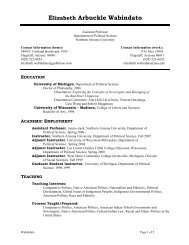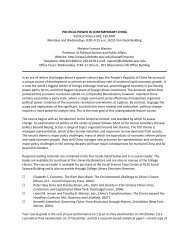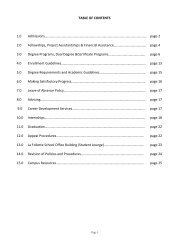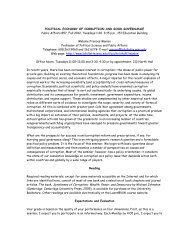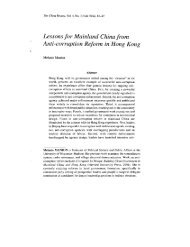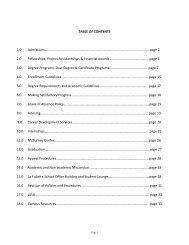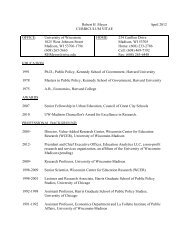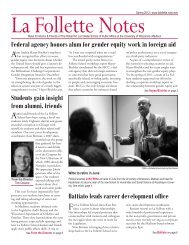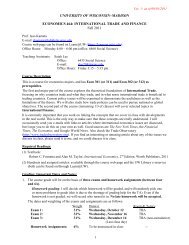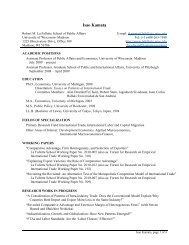SAVE Commission's findings - La Follette School of Public Affairs ...
SAVE Commission's findings - La Follette School of Public Affairs ...
SAVE Commission's findings - La Follette School of Public Affairs ...
Create successful ePaper yourself
Turn your PDF publications into a flip-book with our unique Google optimized e-Paper software.
areas, including vendors competing on a<br />
level playing field with public employees.<br />
5. Technology is<br />
aggressively<br />
tapped. Technology<br />
is revolutionizing<br />
learning in<br />
form and format,<br />
and Wisconsin<br />
must not take a<br />
back seat to<br />
anyone. Learning content can be<br />
developed locally. The state must<br />
provide a convenient, cost effective<br />
distribution system, ensure training<br />
(especially <strong>of</strong> teachers) and promote<br />
Wisconsin-relevant content (see Goals<br />
#12 and #14).<br />
6. Learning happens any time, any place,<br />
in many ways. Learning, especially<br />
using interactive technology, should be<br />
permitted to take place anywhere,<br />
anytime. Employers, teachers, entrepreneurs,<br />
private schools, home schools,<br />
cooperatives, charter schools and places<br />
yet to be invented all will contribute to<br />
learning. The state promotes this<br />
diversity and creativity as part <strong>of</strong> the<br />
new Wisconsin Idea (see Goal #3).<br />
7. The state is a helping hand. The state<br />
educational<br />
function should<br />
shift from controlling<br />
K-12<br />
formal education<br />
to leading the<br />
policy crusade for<br />
lifelong learning<br />
as it can be<br />
delivered by<br />
many providers in many places through<br />
new, exciting technological means. The<br />
state will still need to assess and evaluate,<br />
but focus on results, not paperwork<br />
and not with a heavy fist, but a guiding<br />
hand.<br />
8. The state education governance system<br />
is seamless. The state’s educational<br />
structure, from pre-school to higher<br />
“There are too many local units<br />
<strong>of</strong> government, including<br />
school districts.”<br />
Mark Rogacki, Wisconsin Counties Association<br />
“I’d like to see the vocational<br />
school system develop more job<br />
training for economically<br />
disadvantaged people.”<br />
Anthony Vang, Wausau<br />
education, must evolve into a seamless<br />
system. That concept may seem unobtainable<br />
given the pride and protectiveness<br />
<strong>of</strong> existing<br />
institutions, but it<br />
must happen. There<br />
must be a new<br />
oversight system that<br />
meets the 21st<br />
Century definition <strong>of</strong><br />
education and detaches,<br />
once and for<br />
all, from a model that traces its roots to<br />
the days <strong>of</strong> King Arthur.<br />
A SECRETARY FOR EDUCATION<br />
The first step into educational leadership<br />
for the future will come with creation <strong>of</strong> a Secretary<br />
and Department for Education that have<br />
a vision beyond existing interests and institutions.<br />
The Governor will appoint the Secretary,<br />
in partnership with a citizen board, confirmed<br />
by the Senate.<br />
The Secretary will lead an agency committed<br />
to and held accountable for educational<br />
excellence. The position will have a role quite<br />
different from the current Superintendent <strong>of</strong><br />
<strong>Public</strong> Instruction. The current <strong>of</strong>fice focuses<br />
on control <strong>of</strong> formal K-12 education. The Secretary<br />
will see education as something everyone<br />
should be involved in, not just certified<br />
public educators, administrators<br />
and teachers.<br />
This new leader<br />
for education will see<br />
education as beginning<br />
before the classroom,<br />
in the home and at day<br />
care and preschool.<br />
The state will be a<br />
helper and advocate for<br />
early childhood education, using tools such as<br />
the <strong>Public</strong> Information Utility (see Goal #12).<br />
The Secretary also will be a strong advocate for<br />
the Village Partnership concept, the model for<br />
decentralized and parental ownership in school<br />
site education now being tested in the state.<br />
Finally, the Secretary will champion<br />
school-to-work transition programs and be a<br />
partner with business, private teachers and<br />
Actions<br />
10.1<br />
Create a Department<br />
for Education, headed<br />
by a cabinet secretary.<br />
10.2<br />
Prepare educational<br />
boards for greater<br />
effectiveness and<br />
accountability.<br />
10.3<br />
Study administrative<br />
efficiencies.<br />
10.4<br />
Consider county or<br />
multi-county educational<br />
administration<br />
units.<br />
10.5<br />
Direct the state CESA<br />
system to achieve<br />
greater local<br />
cooperation between<br />
K-12 districts and<br />
Technical Colleges.<br />
Jill Reiche, Wausau<br />
“We need to take a look<br />
at the schools and make<br />
kids our priority.”<br />
Linda McMullin, <strong>La</strong><br />
Crosse<br />
“All school board<br />
members should take a<br />
two-day workshop on<br />
their role and<br />
responsibilities.”<br />
CITIZEN • COMMUNITY • GOVERNMENT — WISCONSIN: THE 21 ST CENTURY 31



